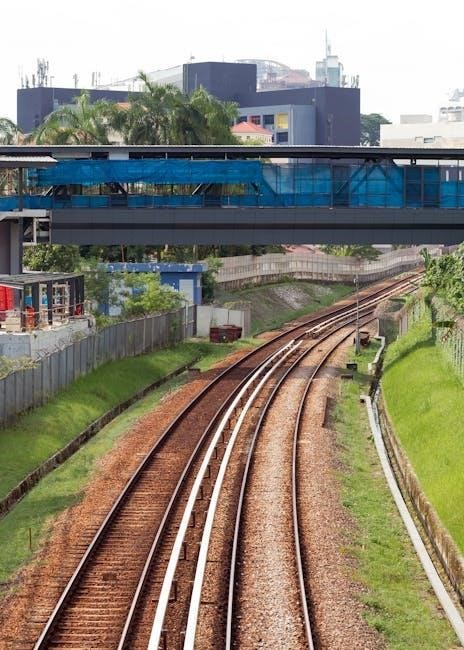
linear guide rails
Discover durable linear guide rails designed for smooth motion control. Ideal for industrial machinery and automation systems.
Linear guide rails are essential components in machinery, enabling smooth, precise motion in straight lines. They support heavy loads and ensure high positional accuracy, making them indispensable in various industrial applications.
1.1 Definition and Purpose
Linear guide rails are mechanical components designed to facilitate smooth, precise linear motion. They consist of rails and carriages with integrated bearings, enabling objects to move along a straight path with minimal friction. Their primary purpose is to support and guide heavy loads accurately in industrial machinery, ensuring efficient and reliable operation across various applications.
1.2 Historical Development
Linear guide rails evolved from early linear motion solutions, with significant advancements in the 20th century. Initially, simple slides and bearings were used, but modern designs incorporate rolling elements like balls or rollers for smoother operation. The development of high-precision materials and advanced manufacturing techniques has improved their performance, enabling their widespread use in industrial automation, robotics, and CNC machines. This evolution reflects the growing demand for precise and reliable motion control in modern engineering.
1.3 Importance in Modern Machinery
Linear guide rails are critical in modern machinery due to their ability to provide precise and smooth motion control. They are essential in industrial automation, CNC machines, and robotic systems, enabling high-speed and high-accuracy operations. Additionally, they support heavy loads while maintaining minimal friction, making them vital for applications requiring durability and efficiency. Their reliability ensures consistent performance in demanding environments, contributing significantly to the overall functionality and productivity of advanced machinery.
Key Components of Linear Guide Rails
Linear guide rails consist of rails, carriages, bearings, and end caps. These components work together to enable smooth, precise motion and load support in machinery.
2.1 Rails
Rails are the foundational structures in linear guide systems, providing the pathway for carriages to move smoothly. Typically made from hardened steel, stainless steel, or aluminum, they offer high strength and durability. The rails are precisely manufactured to ensure minimal wear and optimal performance. Their surface is often ground or hardened to achieve high precision and load capacity. Some rails feature protective coatings or covers to prevent contamination. They are designed to support varying loads, from light to heavy-duty applications, ensuring reliable operation in diverse machinery and equipment.
2.2 Carriages
Carriages are the moving components that ride along the rails, providing a platform for mounting loads. They are typically made from durable materials like steel or aluminum and feature integrated bearings for smooth motion. Designed to handle various loads, carriages are available in different sizes and configurations to suit specific applications. They often include mounting holes for easy installation and may have seals or caps to protect internal mechanisms from dust and debris, ensuring reliable performance and longevity in industrial environments.

2.3 Bearings
Bearings are critical components within linear guide systems, enabling smooth motion by reducing friction between the carriage and rail. They are typically made from steel or stainless steel for durability. Ball bearings are the most common, offering high precision and low friction, while roller bearings are used for heavier loads. Proper lubrication is essential to extend their lifespan and ensure optimal performance. Bearings are designed to handle both static and dynamic loads, making them indispensable for precise and reliable linear motion in industrial applications.
2.4 End Caps and Seals
End caps and seals are vital for protecting linear guide rails from dust, debris, and contaminants. They are installed at the ends of the carriages to prevent foreign particles from entering the system. Seals also help retain lubrication, ensuring smooth operation and extending the lifespan of the bearings. Properly fitted end caps and seals enhance durability and maintain precision by safeguarding the internal components from environmental factors. They are essential for maintaining optimal performance in industrial applications.

Types of Linear Guide Rails
Linear guide rails are categorized into ball, roller, and needle roller types, each offering distinct advantages in load capacity, precision, and application suitability.
3.1 Ball Guide Rails
Ball guide rails use balls as rolling elements, offering smooth motion and high precision. They are ideal for high-speed applications and provide low friction, ensuring energy efficiency. These rails are commonly used in CNC machines and robotic systems due to their ability to handle both static and dynamic loads effectively. The ball bearings are typically recirculating, allowing for continuous motion along the rail. Their compact design and durability make them a popular choice for industrial automation and precise machinery operations.

3.2 Roller Guide Rails
Roller guide rails utilize cylindrical rollers, providing higher load-carrying capacity compared to ball guide rails. They are suitable for heavy-duty applications and offer excellent resistance to shock loads. Rollers maintain consistent contact with the rail, ensuring stability and reduced vibration. These systems are often used in large machinery and industrial equipment where robust performance is required. The roller design allows for smoother operation under heavy loads, making them ideal for applications demanding both strength and reliability.
3.3 Needle Roller Guide Rails
Needle roller guide rails employ thin, cylindrical rollers, enabling high load capacity in compact spaces; They are ideal for applications requiring precise linear motion under heavy loads. These rails are commonly used in industrial machinery and automated systems, offering excellent resistance to shock loads. Their design incorporates steel cages to maintain roller alignment and ensure smooth operation. Needle roller guides are particularly effective in tight spaces, making them a popular choice for applications where space is limited but performance is critical.

Load Capacity and Lifespan
Load capacity and lifespan are critical for linear guide rails. Static and dynamic loads must be considered for optimal performance. Proper lubrication, alignment, and regular maintenance significantly affect durability.
4.1 Static Load Capacity
Static load capacity refers to the maximum weight a linear guide rail can support without moving. It is determined by material quality and design. Exceeding this capacity can cause permanent deformation. Factors like rail material thickness and bearing type significantly influence static load limits. Proper installation and maintenance ensure optimal performance. Excessive loads may lead to premature wear or failure. Always consult manufacturer specifications to avoid overload conditions and ensure longevity of the system. Regular inspections help maintain stability under static conditions.
4.2 Dynamic Load Capacity
Dynamic load capacity measures the maximum weight a linear guide rail can handle while in motion. It considers factors like speed, acceleration, and operating cycles. Exceeding this capacity can lead to accelerated wear or system failure. Proper lubrication and alignment are crucial to maintaining dynamic load limits. Selection of appropriate bearings and materials ensures optimal performance under varying conditions. Regular maintenance helps extend the system’s lifespan and reliability during operation. Always refer to manufacturer guidelines for specific dynamic load ratings to ensure safe and efficient functionality.
4.3 Factors Affecting Lifespan
The lifespan of linear guide rails is influenced by material quality, load distribution, and environmental conditions. Improper mounting or misalignment can lead to uneven wear. High speeds and frequent starts/stops reduce longevity. Exposure to dust or moisture accelerates degradation. Lubrication deficiency or contamination compromises performance. Maintenance neglect shortens service life. Material defects or poor manufacturing practices also impact durability. Environmental factors like temperature and humidity play a role. Proper installation and regular upkeep are critical to maximizing lifespan.
4.4 Calculation Methods
Calculating load capacity and lifespan involves analyzing static and dynamic loads, speed, and acceleration. Formulas consider bearing type, rail material, and environmental factors. The basic load rating (C) and dynamic equivalent load (P) are key. Lubrication conditions and contamination levels are evaluated. Specialized software or charts may be used for precise calculations. Manufacturer guidelines often provide specific methods. Regular maintenance and inspection data also inform lifespan estimates. Accurate calculations ensure optimal performance and longevity of the linear guide system.

Applications of Linear Guide Rails
Linear guide rails are widely used in CNC machines, robotic systems, medical equipment, and aerospace engineering, providing high precision and reliability in various industrial and technical applications.
5;1 Industrial Automation
Linear guide rails play a crucial role in industrial automation by enabling precise and reliable motion control. They are widely used in automated production lines, material handling systems, and robotic assembly cells. Their high load capacity and smooth operation ensure consistent performance in demanding environments. By providing accurate positioning and reducing friction, these rails enhance the efficiency and productivity of automated manufacturing processes, making them indispensable in modern industrial setups.
5.2 CNC Machines
Linear guide rails are integral to CNC machines, ensuring precise and repeatable motion for cutting, drilling, and milling operations. Their high rigidity and load-bearing capacity enable accurate tool positioning, critical for producing complex geometries. With minimal backlash and smooth operation, these rails enhance machining efficiency and part quality. They are essential for maintaining the high performance and reliability required in CNC systems, making them a cornerstone of modern manufacturing technology.
5.3 Robotic Systems
Linear guide rails play a crucial role in robotic systems by enabling precise and smooth motion for tasks like assembly, welding, and material handling. Their high load capacity and rigidity ensure robots maintain accuracy and stability under varying conditions. Smooth operation minimizes vibrations, enhancing overall performance. These rails are essential for achieving the high precision and repeatability required in automated systems, making them a cornerstone of modern robotic applications.
5.4 Medical Equipment
Linear guide rails are integral to medical equipment, ensuring precise and smooth motion in devices like patient tables, imaging systems, and surgical robots. Their durability and resistance to contamination make them ideal for sterile environments. High load capacity and low friction enable reliable operation, while smooth motion minimizes vibrations, crucial for sensitive medical procedures. The rails’ ability to handle heavy loads with accuracy ensures the safety and effectiveness of medical equipment, making them indispensable in healthcare settings.
5.5 Aerospace Engineering
Linear guide rails play a critical role in aerospace engineering, where precision and durability are paramount. They are used in aircraft assembly lines, satellite positioning systems, and robotic arms for spacecraft maintenance. The rails’ high load capacity and resistance to extreme temperatures ensure reliable operation in harsh environments. Their smooth motion and minimal vibration are essential for sensitive aerospace applications, such as payload deployment systems. By enabling precise control and stability, linear guide rails contribute significantly to the safety and efficiency of aerospace operations and innovations.

Material Selection
Material selection for linear guide rails is crucial, with options like steel, aluminum, and stainless steel offering durability, lightweight, and corrosion resistance for various industrial applications.
6.1 Steel Rails
Steel rails are the most common choice for linear guide systems due to their high strength and durability. They are often case-hardened to enhance resistance to wear and impact, making them ideal for heavy-duty applications. Steel rails provide excellent load capacity and maintain precision under demanding conditions. However, they are heavier and more expensive than aluminum options. Despite this, their robustness and thermal stability make them a preferred choice for industrial machinery and high-performance systems requiring reliability and longevity.
6.2 Aluminum Rails
Aluminum rails are lightweight and corrosion-resistant, making them suitable for applications where weight reduction is critical. They are often used in automation and robotics due to their ability to support high-speed movements with minimal inertia. Aluminum rails are cost-effective and easier to machine than steel, allowing for custom designs. However, they have lower load capacities and may not perform as well in extreme temperatures or heavy-duty environments, limiting their use in certain industrial settings where strength is paramount.
6.3 Stainless Steel Rails
Stainless steel rails are highly durable and resistant to corrosion, making them ideal for harsh environments. They offer excellent strength-to-weight ratios and can withstand heavy loads without deformation. Stainless steel rails are commonly used in food processing, medical equipment, and marine applications due to their resistance to moisture and chemicals. While more expensive than aluminum, they provide long-term reliability and require minimal maintenance, ensuring consistent performance in demanding conditions. Their corrosion resistance also extends their service life in industrial settings.
6.4 Polymer-Coated Rails
Polymer-coated rails offer enhanced corrosion resistance and reduced noise during operation. The polymer layer provides a smooth surface, minimizing friction and wear. These rails are ideal for applications requiring low maintenance and resistance to environmental factors. They are cost-effective and suitable for light to medium loads. Polymer coatings also protect against chemical exposure, making them a great choice for industries like food processing or medical equipment. Their durability ensures long-term performance in various operating conditions, particularly where metal-to-metal contact needs to be avoided.
Installation and Maintenance
Proper installation and regular maintenance are crucial for optimal performance and longevity of linear guide rails. Ensure alignment, lubrication, and cleanliness to prevent wear and extend service life.
7.1 Mounting Methods
Mounting linear guide rails requires precise alignment to ensure smooth operation. Proper alignment prevents misalignment, which can lead to premature wear. Rails should be securely fastened using appropriate fasteners to avoid movement during operation. For optimal results, rails are typically mounted in an H7 tolerance bore to ensure a snug fit. This method ensures stability and minimizes the risk of positional errors. Additionally, using shims can help maintain parallelism between rails, ensuring consistent performance and longevity of the system. Proper mounting is critical for achieving the desired motion accuracy and durability.
7.2 Lubrication Requirements
Lubrication is essential for linear guide rails to reduce friction and prevent wear. Regular lubrication ensures smooth operation and extends lifespan. Use high-quality grease or oil suitable for the operating conditions. Clean the rails before applying lubricant to avoid contamination. Excessive lubrication can attract dirt, leading to premature wear. Proper lubrication maintenance is critical for optimal performance and durability.
7.3 Alignment and Adjustment
Proper alignment of linear guide rails is crucial for smooth operation and longevity. Misalignment can cause uneven wear and reduced performance. Use shims or adjustment screws to ensure the rail is parallel to the motion plane. Regularly check and adjust the alignment to maintain precision. Incorrect alignment can lead to increased friction and premature wear. Some systems may require specialized tools for precise adjustments. Always refer to the manufacturer’s guidelines for specific alignment procedures. Proper adjustment ensures optimal functionality and extends the service life of the guide rails.
7.4 Regular Maintenance Tips
Regular maintenance is essential to ensure the longevity and optimal performance of linear guide rails. Clean the rails and carriages frequently to remove dirt and debris. Apply the recommended lubricant to prevent corrosion and wear. Inspect the system for signs of wear or misalignment and address issues promptly. Replace seals or bearings as needed to maintain smooth operation. Schedule periodic checks to ensure all components are functioning correctly. Proper maintenance helps prevent downtime and extends the service life of the system.

Advantages of Linear Guide Rails
Linear guide rails provide high precision, smooth motion, and durability, making them ideal for industrial automation. They efficiently handle heavy loads and high speeds, enhancing machinery performance.
8.1 High Precision
Linear guide rails offer exceptional precision, ensuring minimal deviation in movement. Their design, featuring rolling elements like balls or rollers, allows for consistent accuracy and repeatability. This makes them ideal for applications requiring tight tolerances, such as CNC machines and robotic systems. The precise alignment and smooth motion enabled by these guides minimize positional errors, enhancing overall machining quality and operational efficiency in industrial settings.
8.2 Smooth Motion
Linear guide rails ensure smooth motion by minimizing friction and vibration. The use of rolling elements, such as balls or rollers, allows for consistent and fluid movement. This smooth operation is critical in applications requiring precise control, such as robotic systems and medical equipment. The even distribution of load and reduced friction contribute to efficient operation, making these guides ideal for high-performance machinery. Smooth motion also reduces wear on associated components, enhancing overall system longevity and reliability.
8.3 High Load Capacity
Linear guide rails are designed to handle significant loads while maintaining precision and stability. Their robust construction and durable materials enable them to support heavy weights without compromising performance. The use of high-quality bearings and optimized designs ensures even load distribution, preventing deformation or wear. This makes them ideal for applications in industrial automation, CNC machines, and robotic systems, where reliable and consistent operation under heavy loads is essential for productivity and efficiency.
8.4 Durability
Linear guide rails are known for their exceptional durability, with robust designs and high-quality materials ensuring long-term performance. They are resistant to wear and tear, even in demanding environments. Proper lubrication and maintenance further enhance their lifespan. Durable construction allows them to withstand heavy loads and repetitive motions without compromising accuracy. This reliability makes them a critical component in industrial and precision engineering applications, where consistent performance over time is essential for operational success and cost efficiency.

Limitations and Challenges
Linear guide rails face challenges like high costs, contamination risks, and maintenance needs, requiring precise alignment and regular care to ensure optimal performance and longevity in applications.
9.1 Cost Considerations
Linear guide rails can be costly due to their precision engineering and high-quality materials. Aluminum rails are more affordable but less durable, while steel rails, though expensive, offer superior strength. Custom sizes and advanced features increase prices. Maintenance and replacement costs add to the overall expense, making budget planning crucial for industries relying on these components. Balancing cost and performance is essential for optimal functionality in machinery and automation systems.
9.2 Maintenance Requirements
Regular maintenance is crucial for extending the lifespan of linear guide rails. Proper lubrication prevents wear and tear, while alignment checks ensure smooth operation. Cleaning the rails and carriages from debris is essential to maintain precision. Neglecting maintenance can lead to reduced performance, increased friction, and premature wear. Scheduled inspections and timely replacements of worn parts are vital to uphold functionality and prevent unforeseen machinery downtime, ensuring optimal productivity and efficiency in industrial applications.
9.3 Susceptibility to Contamination
Linear guide rails are highly susceptible to contamination, which can significantly impair their performance. Dust, dirt, and debris can infiltrate the system, causing wear and tear on the bearings and rails. Proper sealing and regular cleaning are essential to prevent contamination. In industrial settings, exposure to harsh environments increases this risk. Lubrication also plays a role in protecting against contaminants. Neglecting contamination control can lead to premature failure, highlighting the importance of maintenance and protective measures in ensuring longevity and reliability.

Future Trends and Innovations
Future trends include advanced materials, smart guides with IoT integration, compact designs, and improved lubrication systems for enhanced performance and efficiency in linear motion applications.
10.1 Advanced Materials
Next-generation linear guide rails will feature advanced materials like lightweight composites, high-strength alloys, and self-lubricating polymers. These innovations aim to enhance durability, reduce weight, and improve thermal stability. Smart materials that adapt to environmental changes are also being explored, offering potential for real-time performance optimization. These advancements will enable linear guides to operate in extreme conditions, such as high temperatures or corrosive environments, expanding their applications in industries like aerospace and renewable energy.
10.2 Smart Linear Guides
Smart linear guides integrate advanced technologies like sensors and IoT connectivity, enabling real-time monitoring of position, temperature, and vibration. These systems provide predictive maintenance alerts, reducing unexpected downtime. By optimizing performance and integrating with automation systems, smart linear guides enhance operational efficiency. They also support Industry 4.0 initiatives, allowing seamless communication between machines. This innovation ensures higher precision, reduced energy consumption, and improved safety in industrial applications, making them a cornerstone of modern smart factories and automated workflows.
10.3 Compact Designs
Compact linear guide designs are increasingly popular due to their space-saving potential. These smaller, lightweight systems maintain high performance while reducing overall dimensions, making them ideal for applications with limited space. Advances in material optimization and miniaturized components enable compact guides to deliver the same reliability and precision as larger models. They are particularly valuable in robotics, medical devices, and portable machinery, where size constraints must be balanced with functionality, ensuring efficient operation without compromising performance or durability.
10.4 Integration with IoT
Integrating linear guide rails with IoT enables real-time monitoring and smart automation; Sensors embedded in the rails collect data on wear, temperature, and load, ensuring predictive maintenance. This connectivity enhances operational efficiency, reduces unplanned downtime, and optimizes performance. IoT-driven systems also facilitate remote monitoring, allowing for timely adjustments and minimizing production interruptions. Such advancements are pivotal in Industry 4.0, where seamless integration of mechanical and digital components is essential for future-proof manufacturing and automation solutions.